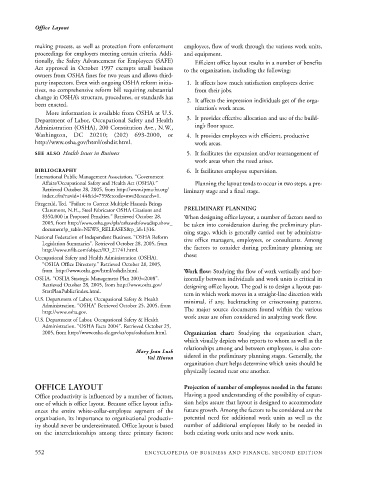Page 575 - Encyclopedia of Business and Finance
P. 575
eobf_O 7/5/06 3:17 PM Page 552
Office Layout
making process, as well as protection from enforcement employees, flow of work through the various work units,
proceedings for employers meeting certain criteria. Addi- and equipment.
tionally, the Safety Advancement for Employees (SAFE) Efficient office layout results in a number of benefits
Act approved in October 1997 exempts small business
to the organization, including the following:
owners from OSHA fines for two years and allows third-
party inspectors. Even with ongoing OSHA reform initia- 1. It affects how much satisfaction employees derive
tives, no comprehensive reform bill requiring substantial from their jobs.
change in OSHA’s structure, procedures, or standards has 2. It affects the impression individuals get of the orga-
been enacted.
nization’s work areas.
More information is available from OSHA at U.S.
Department of Labor, Occupational Safety and Health 3. It provides effective allocation and use of the build-
Administration (OSHA), 200 Constitution Ave., N.W., ing’s floor space.
Washington, DC 20210; (202) 693-2000, or 4. It provides employees with efficient, productive
http://www.osha.gov/html/oshdir.html. work areas.
SEE ALSO Health Issues in Business 5. It facilitates the expansion and/or rearrangement of
work areas when the need arises.
BIBLIOGRAPHY 6. It facilitates employee supervision.
International Public Management Association. “Government
Affairs/Occupational Safety and Health Act (OSHA).” Planning the layout tends to occur in two steps, a pre-
Retrieved October 28, 2005, from http://www.ipma-hr.org/ liminary stage and a final stage.
index.cfm?navid=144&id=759&tcode=nws3&search=1.
Fitzgerald, Ted. “Failure to Correct Multiple Hazards Brings
Claremont, N.H., Steel Fabricator OSHA Citations and PRELIMINARY PLANNING
$350,000 in Proposed Penalties.” Retrieved October 28, When designing office layout, a number of factors need to
2005, from http://www.osha.gov/pls/oshaweb/owadisp.show_ be taken into consideration during the preliminary plan-
document?p_table=NEWS_RELEASES&p_id=1316.
ning stage, which is generally carried out by administra-
National Federation of Independent Business. “OSHA Reform tive office managers, employees, or consultants. Among
Legislation Summaries”. Retrieved October 28, 2005, from
http://www.nfib.com/object/IO_21741.html. the factors to consider during preliminary planning are
these:
Occupational Safety and Health Administration (OSHA).
“OSHA Office Directory.” Retrieved October 28, 2005,
from http://www.osha.gov/html/oshdir.html. Work flow: Studying the flow of work vertically and hor-
OSHA. “OSHA Strategic Management Plan 2003–2008”. izontally between individuals and work units is critical in
Retrieved October 28, 2005, from http://www.osha.gov/ designing office layout. The goal is to design a layout pat-
StratPlanPublic/index.html.
tern in which work moves in a straight-line direction with
U.S. Department of Labor, Occupational Safety & Health minimal, if any, backtracking or crisscrossing patterns.
Administration. “OSHA” Retrieved October 25, 2005, from
http://www.osha.gov. The major source documents found within the various
work areas are often considered in analyzing work flow.
U.S. Department of Labor, Occupational Safety & Health
Administration. “OSHA Facts 2004”. Retrieved October 25,
2005, from http://www.osha-slc.gov/as/opa/oshafacts.html. Organization chart: Studying the organization chart,
which visually depicts who reports to whom as well as the
relationships among and between employees, is also con-
Mary Jean Lush
Val Hinton sidered in the preliminary planning stages. Generally, the
organization chart helps determine which units should be
physically located near one another.
OFFICE LAYOUT Projection of number of employees needed in the future:
Office productivity is influenced by a number of factors, Having a good understanding of the possibility of expan-
one of which is office layout. Because office layout influ- sion helps assure that layout is designed to accommodate
ences the entire white-collar-employee segment of the future growth. Among the factors to be considered are the
organization, its importance to organizational productiv- potential need for additional work units as well as the
ity should never be underestimated. Office layout is based number of additional employees likely to be needed in
on the interrelationships among three primary factors: both existing work units and new work units.
552 ENCYCLOPEDIA OF BUSINESS AND FINANCE, SECOND EDITION

